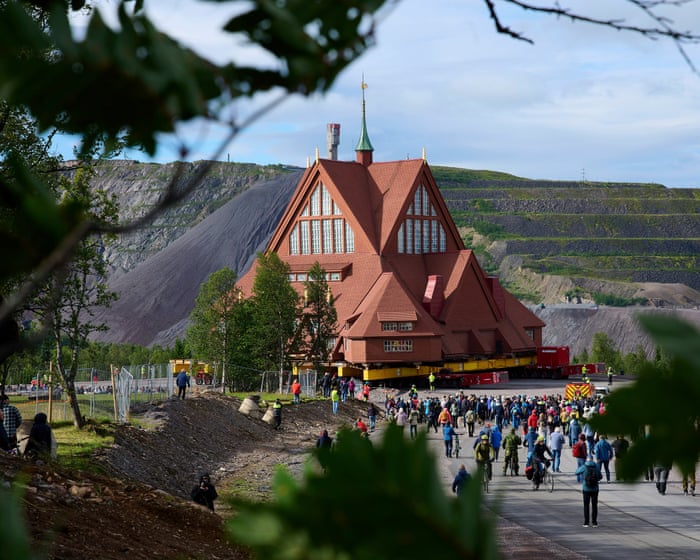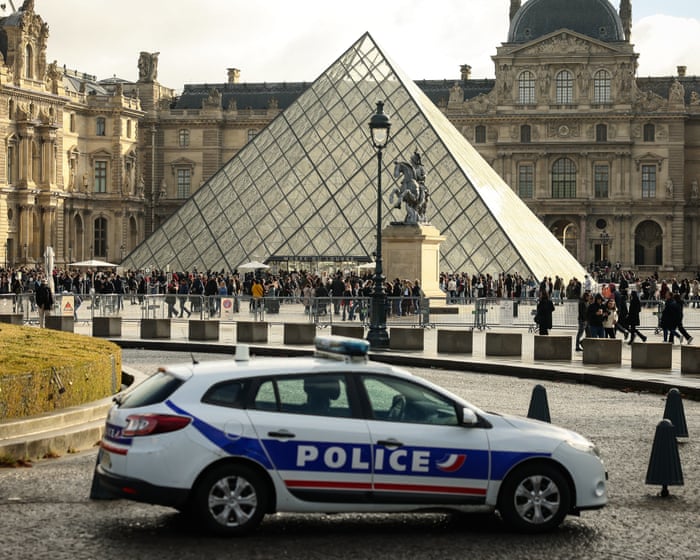Etter åtte års planlegging og til en estimert kostnad på 500 millioner kroner (39 millioner pund), startet en kirke i Nord-Sverige tirsdag en langsom, 5 kilometer lang reise for å gi plass til utvidelsen av Europas største underjordiske gruve. Flyttingen fulgte en velsignelse tidlig på morgenen.
Den 672 tonn tunge Kiruna Kyrka, en svensk luthersk kirke innviet i 1912, blir rullet til sin nye plassering over to dager med en hastighet på en halv kilometer i timen.
Omleggingen er en del av en massiv, flere tiår lang innsats for å flytte hele den arktiske byen, ettersom jerngruven drevet av det statlige selskapet LKAB forårsaker at bakken svekkes og truer med å svelge samfunnet.
Mer enn 10 000 mennesker, inkludert Sveriges kong Carl XVI Gustaf, ventes å stille opp langs de spesielt utvidede gatene for å se den røde trebygningen ta sin reise. En vellykket prøveflytting ble utført over en 30 meter lang strekning i helgen.
Dusinvis av kameraer er satt opp langs ruten, noe som gjør at folk over hele Sverige og verden kan se på det kringkasteren SVT kaller «Den stora kyrkflytten» – en ny form for «saktev-TV».
Designet av Gustaf Wickman, er kirken en av Sveriges mest verdsatte historiske bygninger, kjent for sin arkitektur som ligner en samisk lavvo (et tradisjonelt hus).
Onsdag vil det bli holdt en gudstjeneste og kaffesamling i et forsøk på å slå verdensrekorden for den største kirkekaffeen. Det vil også være musikkopptredener, inkludert en konsert med sangeren Carola.
Kirken forventes å gjenåpne på sin nye plassering innen utgangen av neste år, selv om den fullstendige omleggingen av byen ikke ventes ferdig før 2035.
Kirken er en av 23 kulturelle bygninger som flyttes i det LKAB har kalt «en unik hendelse i verdenshistorien». Gruveselskapet tilbød innbyggerne valget mellom økonomisk kompensasjon eller gjenoppbygging av hjem og strukturer berørt av flyttingen.
Utvidelsen har møtt kritikk, også fra noen samer som bekymrer seg for at landfragmentering vil gjøre reinsdyrdrift vanskeligere.
«Når det gjaldt kirken, bestemte vi at det var best å flytte den i ett stykke. Vi så verdien i det,» fortalte LKABs prosjektleder Stefan Holmblad Johansson til AFP. «Vi har nærmet oss dette prosjektet med stor ærefrykt. Dette er ikke en hvilken som helst bygning – det er en kirke.»
Altertavlen, et pastellandskap av den avdøde svenske prins Eugen, og orgelet med over 20 000 piper ble nøye innpakket for reisen. Bakken rundt kirkens opprinnelige plassering ble gravd ut for at bjelker kunne plasseres under.
«Kirken hviler på et bjelkesystem, og deretter ble to rader med trailere skjøvet under bjelkene,» forklarte Holmblad Johansson.
Klokketårnet, som står separat, vil bli flyttet neste uke.
Ofte stilte spørsmål
Selvfølgelig. Her er en liste over vanlige spørsmål om en historisk svensk kirke som flyttes, designet for å være tydelig og hjelpsom for et bredt spekter av lesere.
**Generelle / begynnerspørsmål**
**Q: Hvorfor flytter de en hel kirke?**
A: Kirken ligger i et område som synker på grunn av omfattende gruvedrift. For å redde den fra potensiell skade eller kollaps, blir den flyttet til en ny, stabil plassering.
**Q: Hvilken kirke er det?**
A: Det er den hvite trekirken fra 1900-tallet i landsbyen Kiruna, ofte kalt Kiruna kirke eller Kiruna kyrka.
**Q: Hvordan flytter man en så stor bygning?**
A: Kirken blir sakte dyttet langs et midlertidig sporsystem ved hjelp av hydrauliske jekker. Den er plassert på en sterk, spesialbygd stålramme med hjul for reisen.
**Q: Hvor langt og hvor fort flyttes den?**
A: Den flyttes omtrent 5 kilometer. Flyttingen er veldig langsom, med en hastighet på omtrent 3 meter i timen for å sikre sikkerhet og stabilitet.
**Q: Er dette første gang noe slikt skjer?**
A: Selv om det å flytte store bygninger er en kjent ingeniørbedrift, er det å flytte en historisk, elsket struktur av denne størrelsen og kulturelle betydningen en sjelden og monumentbegivenhet.
**Avanserte / tekniske spørsmål**
**Q: Hva er de største ingeniørutfordringene ved en slik flytting?**
A: Hovedutfordringene er å sikre at bygningens strukturelle integritet ikke blir svekket, å navigere endringer i høyde og terreng, og å beskytte det skjøre interiøret mot vibrasjoner.
**Q: Hvor mye koster et slikt prosjekt, og hvem betaler for det?**
A: Hele byflytteprosjektet, som inkluderer kirken og mange andre bygninger, koster milliarder av svenske kroner. Det er primært finansiert av det statlige gruveselskapet LKAB, som er ansvarlig for grunnsetningen.
**Q: Hva skjer med kirkens opprinnelige fundament og kirkegård?**
A: Bygningen blir skilt fra sitt opprinnelige fundament. Den tilstøtende kirkegården vil forbli på sin opprinnelige innviede grunn som et minnested, mens nye gravplasser etableres på den nye byplasseringen.
**Q: Vil kirken være nøyaktig den samme etter flyttingen?**
A: Målet er å bevare dens historiske karakter og utseende nøyaktig. Imidlertid gir flyttingen en mulighet til diskret oppgradering av ting som elektriske systemer og isolering, som ikke vil være synlige.




